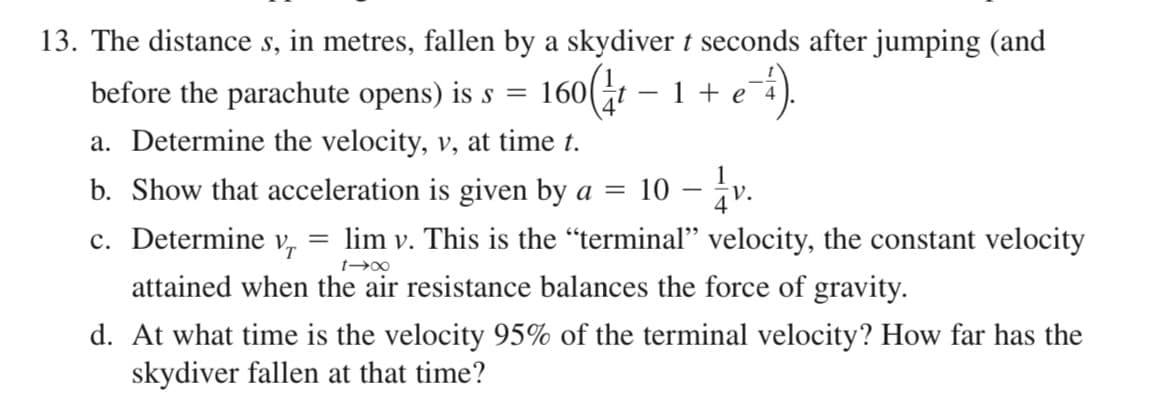13. The distance s, in metres, fallen by a skydiver t seconds after jumping (and 160(:1 – 1 + e-5. before the parachute opens) is s = 160(t – 1 + e¯4 a. Determine the velocity, v, at time t. b. Show that acceleration is given by a = 10 - v c. Determine v, = lim v. This is the "terminal" velocity, the constant velocity attained when the air resistance balances the force of gravity. d. At what time is the velocity 95% of the terminal velocity? How far has the skydiver fallen at that time?
13. The distance s, in metres, fallen by a skydiver t seconds after jumping (and 160(:1 – 1 + e-5. before the parachute opens) is s = 160(t – 1 + e¯4 a. Determine the velocity, v, at time t. b. Show that acceleration is given by a = 10 - v c. Determine v, = lim v. This is the "terminal" velocity, the constant velocity attained when the air resistance balances the force of gravity. d. At what time is the velocity 95% of the terminal velocity? How far has the skydiver fallen at that time?
Functions and Change: A Modeling Approach to College Algebra (MindTap Course List)
6th Edition
ISBN:9781337111348
Author:Bruce Crauder, Benny Evans, Alan Noell
Publisher:Bruce Crauder, Benny Evans, Alan Noell
Chapter2: Graphical And Tabular Analysis
Section2.1: Tables And Trends
Problem 1TU: If a coffee filter is dropped, its velocity after t seconds is given by v(t)=4(10.0003t) feet per...
Related questions
Question

Transcribed Image Text:13. The distance s, in metres, fallen by a skydiver t seconds after jumping (and
160(:1 – 1 + e-5.
before the parachute opens) is s =
160(t – 1 + e¯4
a. Determine the velocity, v, at time t.
b. Show that acceleration is given by a =
10 - iv
c. Determine v, = lim v. This is the “terminal" velocity, the constant velocity
attained when the air resistance balances the force of gravity.
d. At what time is the velocity 95% of the terminal velocity? How far has the
skydiver fallen at that time?
Expert Solution
This question has been solved!
Explore an expertly crafted, step-by-step solution for a thorough understanding of key concepts.
Step by step
Solved in 3 steps with 3 images

Recommended textbooks for you

Functions and Change: A Modeling Approach to Coll…
Algebra
ISBN:
9781337111348
Author:
Bruce Crauder, Benny Evans, Alan Noell
Publisher:
Cengage Learning

Trigonometry (MindTap Course List)
Trigonometry
ISBN:
9781337278461
Author:
Ron Larson
Publisher:
Cengage Learning


Functions and Change: A Modeling Approach to Coll…
Algebra
ISBN:
9781337111348
Author:
Bruce Crauder, Benny Evans, Alan Noell
Publisher:
Cengage Learning

Trigonometry (MindTap Course List)
Trigonometry
ISBN:
9781337278461
Author:
Ron Larson
Publisher:
Cengage Learning
